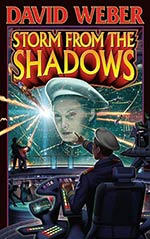
![]() Sable Aradia
Sable Aradia
6/20/2019
![]()
I chewed through the Honorverse Saga over the last little while because a housemate is also reading the series, and I'm trying to keep ahead of him so that we can talk about it. So expect a lot of Honorverse reviews from me in the near future.
This book is a significant departure in style from Weber's other Honorverse works. As a result, it has gotten mixed reviews. Some readers accept it as a natural extension of previously-established technique and perspectives; others dislike it because it loses some of the personal third-person focus that has characterized many other books in the series.
I find myself wondering at what Weber's process was when writing this and the remainder of the series. Many of the events are repeated from other books. I suspect he said to himself:
"Okay, I've got this huge George R.R. Martin-style saga to tell, but if I did it that way, I'd have a book so thick you could use it as a brick with a little mortar. Welp; I'm really telling three different stories, aren't I? So which events fit into the three different stories? Story one: Honor's perspective. Story two: Cachat and Zilwicki. Story three: Michelle Henke and Saganami Island. Let's divide them up with post-it notes."
And then he set about telling those three separate stories. He lets you know that because he starts giving timeline information (ie. one section of chapters will appear under a heading like "March 1921 Post-Diaspora").
As a result, some events are repeated, because some events are places where the three stories, and their characters, intersect. Sometimes he's able to tell them in a way that provides new events and new insights. Sometimes he isn't. I would argue you could skip those redone scenes, but skimthem so that you know you haven't missed anything important.
I'm not sure he wouldn't have been better off telling all three storylines at once; or perhaps, merging the Honor and Saganami Island storylines and leaving Cachat and Zilwicki their own space (because he co-writes that storyline with Eric Flint.) But I can see why he didn't. The story is really just too damn big for that. Not even Baen would publish it that way! So it's the limitations of the genre that dictates the form.
On the other hand, BIG stories are a hallmark of good space opera.
This book, admittedly, suffers by the division when considered on its own. A lot of it feels like exposition and backstory. Secondary characters end up giving us a lot of it. I don't mind that, but I would suggest he'd have done better with the intense third-person personal style of Martin that way. He's clearly not as invested in some of these secondary characters as he is in Honor and Mike, Cachat and Zilwicki. That's okay, but the result is that some of the voices sound more... distant, or impersonal, than they ought to.
Now that I've read the series to the end, I'm probably going to re-read these last several books simultaneously. That is, I'm going to stack them all on my table, start with the earliest date in the sequencing, and go through all the books reading what happened in that month. Then I'm going to go on to the next month and do the same thing. And so on. I suspect it will have much more immediacy and intensity that way.
But when you consider this book as a complete unit, it's backstory. You need it to understand what's going on in the rest of the books, and there are individual stories of secondary characters worth following. So read it if you're reading the series. But if you're focused on the adventures of the major characters, skim this one for the places where Honor, Mike and Aivars appear, and glance through the rest.
Follow my True Chronological Reading of the Last 10 Honorverse Books at my blog!
http://www.dianemorrisonfiction.com